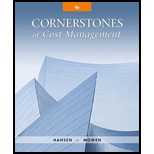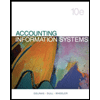
For each of the following situations, two scenarios are described, labeled A and B. Choose which scenario is descriptive of a setting corresponding to activity-based responsibility accounting and which is descriptive of financial-based responsibility accounting. Provide a brief commentary on the differences between the two systems for each situation, addressing the possible advantages of the activity-based view over the financial-based view.
Situation 1
A: The purchasing manager, receiving
B: The plant manager commended the manager of the Grinding Department for increasing his department’s machine utilization rates—and doing so without exceeding the department’s budget. The plant manager then asked other department managers to make an effort to obtain similar efficiency improvements.
Situation 2
A: Delivery mistakes had been reduced by 70 percent, saving over $40,000 per year. Furthermore, delivery time to customers had been cut by two days. According to company policy, the team responsible for the savings was given a bonus equal to 25 percent of the savings attributable to improving delivery quality. Company policy also provided a salary increase of 1 percent for every day saved in delivery time.
B: Bill Johnson, manager of the Product Development Department, was pleased with his department’s performance on the last quarter’s projects. They had managed to complete all projects under budget, virtually assuring Bill of a fat bonus, just in time to help with this year’s Christmas purchases.
Situation 3
A: “Harvey, don’t worry about the fact that your department is producing at only 70 percent capacity. Increasing your output would simply pile up inventory in front of the next production department. That would be costly for the organization as a whole. Sometimes, one department must reduce its performance so that the performance of the entire organization can improve.”
B: “Susan, I am concerned about the fact that your department’s performance measures have really dropped over the past quarter. Labor usage variances are unfavorable, and I also see that your machine utilization rates are down. Now, I know you are not a bottleneck department, but I get a lot of flack when my managers’ efficiency ratings drop.”
Situation 4
A: Colby was muttering to himself. He had just received last quarter’s budgetary performance report. Once again, he had managed to spend more than budgeted for both materials and labor. The real question now was how to improve his performance for the next quarter.
B: Great! Cycle time had been reduced and, at the same time, the number of defective products had been cut by 35 percent. Cutting the number of defects reduced production costs by more than planned. Trends were favorable for all three performance measures.
Situation 5
A: Cambry was furious. An across-the-board budget cut! “How can they expect me to provide the computer services required on less money? Management is convinced that costs are out of control, but I would like to know where—at least in my department!”
B: After a careful study of the Accounts Payable Department, it was discovered that 80 percent of an accounts payable clerk’s time was spent resolving discrepancies between the purchase order, receiving document, and the supplier’s invoice. Other activities such as recording and preparing checks consumed only 20 percent of a clerk’s time. A redesign of the procurement process eliminated virtually all discrepancies and produced significant cost savings.
Situation 6
A: Five years ago, the management of Breeann Products commissioned an outside engineering consulting firm to conduct a time-and-motion study so that labor efficiency standards could be developed and used in production. These labor efficiency standards are still in use today and are viewed by management as an important indicator of productive efficiency.
B: Janet was quite satisfied with this quarter’s labor performance. When compared with the same quarter of last year, labor productivity had increased by 23 percent. Most of the increase was due to a new assembly approach suggested by production line workers. She was also pleased to see that materials productivity had increased. The increase in materials productivity was attributed to reducing scrap because of improved quality.
Situation 7
A: “The system converts materials into products, not people at work stations. Therefore, process efficiency is more important than labor efficiency—but we also must pay particular attention to those who use the products we produce, whether inside or outside the firm.”
B: “I was quite happy to see a revenue increase of 15 percent over last year, especially when the budget called for a 10 percent increase. However, after reading the recent copy of our trade journal, I now wonder whether we are doing so well. I found out that the market expanded by 30 percent, and our leading competitor increased its sales by 40 percent.”
Trending nowThis is a popular solution!

Chapter 12 Solutions
Cornerstones of Cost Management (Cornerstones Series)
- A responsibility center in which managers are held accountable for both revenues and expenses is called a ______. A. discretionary cost center B. revenue center C. cost center D. profit centerarrow_forwardWhen managerial accountants design an evaluation system that is based on criteria for which a manager is responsible, and it is structured to encourage managers to make decisions that will meet the goals of the company as well as their own personal job goals, the framework used is _______. A. a controllable factors framework B. an uncontrollable factors framework C. a strategic plan framework D. a responsibility accounting frameworkarrow_forwardAn effective managerial accounting system should track information about an organizations activities in which of the following areas? a. Development b. Marketing c. Production d. Design e. All of these.arrow_forward
- An important goal of a responsibility accounting framework is to help ensure which of the following? A. decision-making is made by the top executives. B. investments made by each segment are minimized. C. identification of operating segments that should be closed. D. segment and company financial goals are congruent.arrow_forwardThe actions listed next are associated with either an activity-based operational control system or a traditional operational control system: a. Budgeted costs for the maintenance department are compared with the actual costs of the maintenance department. b. The maintenance department manager receives a bonus for beating budget. c. The costs of resources are traced to activities and then to products. d. The purchasing department is set up as a responsibility center. e. Activities are identified and listed. f. Activities are categorized as adding or not adding value to the organization. g. A standard for a products material usage cost is set and compared against the products actual materials usage cost. h. The cost of performing an activity is tracked over time. i. The distance between moves is identified as the cause of materials handling cost. j. A purchasing agent is rewarded for buying parts below the standard price set by the company. k. The cost of the materials handling activity is reduced dramatically by redesigning the plant layout. l. An investigation is undertaken to find out why the actual labor cost for the production of 1,000 units is greater than the labor standard allowed. m. The percentage of defective units is calculated and tracked over time. n. Engineering has been given the charge to find a way to reduce setup time by 75 percent. o. The manager of the receiving department lays off two receiving clerks so that the fourth-quarter budget can be met. Required: Classify the preceding actions as belonging to either an activity-based operational control system or a traditional control system. Explain why you classified each action as you did.arrow_forwardORGANIZATION STRUCTURE AND SPAN OF CONTROL Refer to the organization charts labeled Structure A and Structure B in the figure for problem 12. Required a. For the organizational structure A, describe the 1. advantages and disadvantages of this structure. 2. impact of the resulting span of control. 3. effect of the organizational structure on employee behavior. b. For the flat organizational structure B, describe the 1. advantages and disadvantages of that organizational structure. 2. impact of the resulting span of control. 3. effect of the organizational structure on employee behavior. c. When determining the appropriate span of control for a company, discuss the factors that should be considered.arrow_forward
- ORGANIZATION STRUCTURE AND SPAN OF CONTROL Refer to the organization charts labeled Structure A and Structure B in the figure for problem 11. Required a. For organizational structure A, describe the 1. advantages and disadvantages of this structure. 2. impact of the resulting span of control. 3. possible effect on employee behavior. b. For organizational structure B, describe the 1. advantages and disadvantages of this structure. 2. impact of the resulting span of control. 3. effect on employee behavior. c. When determining the appropriate span of control, discuss the factors that should be considered.arrow_forwardTaylor Speedy has prepared the following list of statements about managerial accounting, financial accounting, and the functions of management. Identify each statement as true or false. Financial accounting centers on providing information to internal users. Staff positions are directly involved in the companys primary revenue-generating activities. Preparation of budgets is part of financial accounting. Managerial accounting applies only to merchandising and manufacturing companies. Both managerial accounting and financial accounting deal with many of the same economic events.arrow_forwardThe managers of an organization are responsible for performing several broad functions. They are ____________________________. planning, controlling, and selling directing, controlling, and evaluating planning, evaluating, and manufacturing planning, controlling, and evaluatingarrow_forward
- All of the following are examples of managerial accounting activities except ________. A. preparing external financial statements in compliance with GAAP B. deciding whether or not to use automation C. making equipment repair or replacement decisions D. deciding whether or not to use automationarrow_forwardShould a managerial accounting system provide both financial and nonfinancial information? Explain.arrow_forwardAssume you have been hired by Cabelas Sporting Goods. As part of your new role in the accounting department, you have been tasked to set up a responsibility accounting structure for the company. As your first task, your supervisor has asked you to give an example of a cost center, profit center, and an investment center within the Cabelas organization. Your supervisor is a little unsure of the difference between a profit center and investment center and would like you to explain the difference.arrow_forward
- Principles of Accounting Volume 2AccountingISBN:9781947172609Author:OpenStaxPublisher:OpenStax College
 Cornerstones of Cost Management (Cornerstones Ser...AccountingISBN:9781305970663Author:Don R. Hansen, Maryanne M. MowenPublisher:Cengage Learning
Cornerstones of Cost Management (Cornerstones Ser...AccountingISBN:9781305970663Author:Don R. Hansen, Maryanne M. MowenPublisher:Cengage Learning Accounting Information SystemsAccountingISBN:9781337619202Author:Hall, James A.Publisher:Cengage Learning,
Accounting Information SystemsAccountingISBN:9781337619202Author:Hall, James A.Publisher:Cengage Learning,  Pkg Acc Infor Systems MS VISIO CDFinanceISBN:9781133935940Author:Ulric J. GelinasPublisher:CENGAGE L
Pkg Acc Infor Systems MS VISIO CDFinanceISBN:9781133935940Author:Ulric J. GelinasPublisher:CENGAGE L Managerial Accounting: The Cornerstone of Busines...AccountingISBN:9781337115773Author:Maryanne M. Mowen, Don R. Hansen, Dan L. HeitgerPublisher:Cengage LearningPrinciples of Accounting Volume 1AccountingISBN:9781947172685Author:OpenStaxPublisher:OpenStax College
Managerial Accounting: The Cornerstone of Busines...AccountingISBN:9781337115773Author:Maryanne M. Mowen, Don R. Hansen, Dan L. HeitgerPublisher:Cengage LearningPrinciples of Accounting Volume 1AccountingISBN:9781947172685Author:OpenStaxPublisher:OpenStax College





